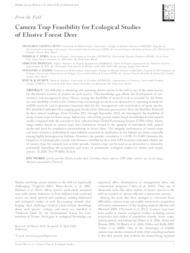Camera trap feasibility for ecological studies of elusive forest deer.
Camera trap feasibility for ecological studies of elusive forest deer.
Author(s): GROTTA NETO, F.; PERES, P. H.; PIOVEZAN, U.; PASSOS, F. C.; DUARTE, J. M. B.
Summary: The difficulty in observing and capturing elusive species in the wild is one of the main reasons for the limited number of studies on such species. This knowledge gap affects the development of conservation and management plans. Hence, testing the feasibility of research tools is essential for the future use and reliability of such tools. Camera traps increasingly are used as an alternative to capturing animals for wildlife research, and to generate important data for the management and conservation of many species. We identified individual free‐ranging gray brocket deer (Mazama gouazoubira) from the Brazilian Pantanal by their natural markings. From October 2011 through September 2012, we investigated the feasibility of using camera traps for home range, habitat use, and activity period studies based on individuals with natural marks compared with the concurrent data collected from Global Positioning System (GPS) collars. Home range studies based on camera traps have limitations related to the quantity of individuals with natural marks and need for population premonitoring to detect them. The irregular performance of camera traps and lower detection probability in open habitats restricted its application in the habitat use study, especially among highly heterogeneous habitats. However, the positive correlation (r = 0.98, P < 0.001) between the frequency of photographic records and distances travelled by deer with GPS locations indicated reliable use of camera traps for research into activity periods. Camera traps can be used as an alternative to telemetry,potentially expanding the perspective and scope of noninvasive ecological studies for elusive and cryptic species.
Publication year: 2020
Types of publication: Journal article
Observation
Some of Embrapa's publications are published as ePub files. To read them, use or download one of the following free software options to your computer or mobile device. Android: Google Play Books; IOS: iBooks; Windows and Linux: Calibre.
Access other publications
Access the Agricultural Research Database (BDPA) to consult Embrapa's full library collection and records.
Visit Embrapa Bookstore to purchase books and other publications sold by Embrapa.

